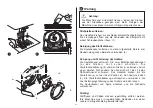
52
Prepare
- Take off the all purpose foot and attach the
buttonhole foot.
- Measure diameter and thickness of button and
add 0.3 cm (1/8") for bartacks to obtain correct
buttonhole length; mark buttonhole size on
fabric (a).
- Place fabric under the foot, so that marking on
the buttonhole foot aligns with starting marking
on fabric. Lower the foot, so that the buttonhole
center line marked on the fabric aligns with the
center of the buttonhole foot (b).
Note:
Density varies according to the fabric.
Always test sew a buttonhole on the fabric
you are using to sew the buttonhole.
Follow the 4-step sequence changing from one
step to another with the pattern selector dial.
When moving from step to step through the
buttonhole process, be sure that the needle is
raised before turning the pattern selector dial to
the next step. Take care not to sew too many
stitches in steps (b) and (d). Use seam ripper and
cut buttonhole open from both ends towards the
middle.
Tips:
- Slightly reducing upper thread tension will
produce better results.
- Use a stabilizer for fine or stretchy fabrics.
- It is advisable to use heavy thread or cord for
stretch or knit fabrics. The zig-zag should sew
over the heavy thread or cord. (5)
Préparation
- Retirer le pied multi-usage et poser le pied pour
boutonnière.
- Mesurer le diamètre et l'épaisseur du bouton et
ajouter 0,3 cm (1/8 de pouce) pour les renforts ;
marquer la taille de la boutonnière sur le tissu.
- Placer le tissu sous le pied, pour que le repère
sur le pied de boutonnière soit aligné au repère
de démarrage sur le tissu. Abaisser le pied,
pour que la ligne centrale de la boutonnière
marquée sur le tissu soit alignée avec le centre
du pied pour boutonnière.
Remarque :
La densité varie selon le tissu.
Il faut toujours réaliser une couture d'essai de
boutonnière sur le tissu que vous utiliserez
pour coudre la boutonnière.
Suivre la séquence à 4 étapes en changeant
d'une étape à l'autre avec le cadran de sélection
de motifs. Lorsque vous passez d'une étape à
une autre dans le processus de réalisation de
boutonnière, assurez que l'aiguille est relevée
avant de tourner le cadran de sélection de motifs
à l'étape suivante. Faire attention de ne pas
coudre trop de points aux étapes (b) et (d).
Utiliser le découvit et ouvrir la boutonnière en
coupant depuis les deux extrémités vers le
milieu.
Astuces :
- Réduire légèrement la tension du fil supérieur
produira de meilleurs résultats.
- Utiliser un entoileur pour les tissus fins ou
extensibles.
- Il est recommandé d'utiliser un fil épais ou un
cordon pour les tissus extensibles ou à mailles.
Le zigzag doit être cousu sur le fil épais ou le
cordon. (5)
Voorbereiden
- Verwijder de universele voet en bevestig de
knoopsgatvoet.
- Meet de diameter en de dikte van de knoop en voeg
0,3 cm (1/8") toe voor de trenzen; markeer de grootte
van het knoopsgat op de stof.
- Leg de stof onder de naaivoet, zodat de markering op
de knoopsgatvoet overeenkomt met de startmarkering
op de stof. Breng de naaivoet omlaag, zodat de
middenlijn van het knoopsgat die op de stof is
aangegeven overeenkomt met het midden van de
knoopsgatvoet.
Opmerking:
De dichtheid verschilt naargelang de stof.
Naai altijd eerst een proefknoopsgat op de stof die u
gaat gebruiken.
Volg de 4-stapsreeks door met de steekkeuzeknop van
de ene stap naar de andere te gaan. Wanneer u van
stap naar stap gaat bij het maken van het knoopsgat,
moet u controleren of de naald omhoog staat voordat u
de steekkeuzeknop naar de volgende stap draait. Let
erop dat u niet te veel steken naait in stap (b) en (d).
Snijd het knoopsgat met een tornmesje open vanaf
beide uiteinden naar het midden toe.
Tips:
- H e t r e s u l t a a t w o r d t m o o i e r a l s u d e
bovendraadspanning iets vermindert.
- Gebruik een versteviging voor dunne of elastische
stoffen.
- Het is aanbevolen dikt garen of koord te gebruiken
voor elastische of gebreide stoffen. De zigzag moet
over het dikke garen of het koord heen naaien. (5)
Naaien van een 4-staps
knoopsgaten
Coudre une boutonnière en 4
étape
Sew 4-step buttonholes
FR
NL
EN






























